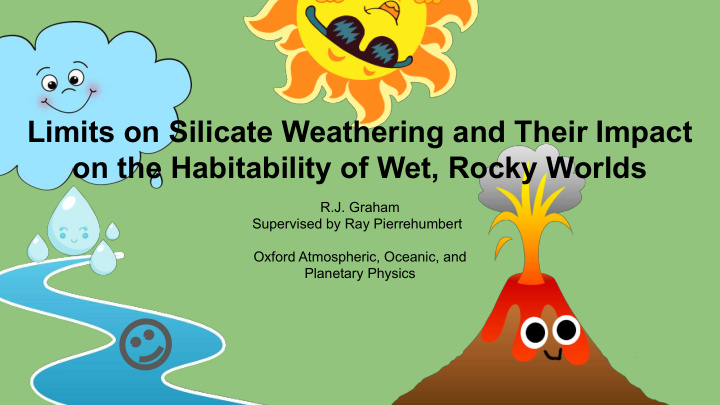



Limits on Silicate Weathering and Their Impact on the Habitability of Wet, Rocky Worlds R.J. Graham Supervised by Ray Pierrehumbert Oxford Atmospheric, Oceanic, and Planetary Physics
Outline 1. Background on the silicate weathering feedback and its proposed influence on climate and planetary habitability 2. How thermodynamics limits silicate weathering 3. How energetic input limits silicate weathering
The sun has brightened by ~32% over its lifetime, but the Earth has maintained a (relatively) stable climate...What’s going on here? Solar luminosity vs. Age (modified from Bahcall et al 2001)
The Carbonate - Silicate Cycle Image credit: Jenny Leibundgut
Rain dissolves silicate minerals and carries the The carbonates Ca 2+ /Mg 2+ ions to are cooked and the ocean the CO 2 is released from The dissolved ions volcanoes react with ocean carbon, forming carbonate rocks The carbonates are subducted Image credit: Jenny Leibundgut
Atmosphere warms More precipitation Silicate weathering and/or faster dissolution speeds up CO 2 builds up CO 2 falls Silicate weathering Less precipitation and/or Atmosphere cools slows down slower dissolution Image credit: Jenny Leibundgut
Hypothesis that underlies the concept of “habitable zone”: Exoplanets with land & oceans will have higher CO 2 at lower instellation due to the silicate weathering feedback (from Bean et al 2017)
But how should silicate weathering be modeled to best predict relationships between temperature, CO 2 , and instellation on rocky worlds?
Imagine a silicate rock in a stream, or, better yet, look several inches below these words
With a high enough flow rate, the water carries away cations as soon as they are produced -- this is kinetically limited weathering Fast flow
In stagnant water, the rock will dissolve until the system reaches equilibrium between dissolving and precipitating minerals. The ions reach a thermodynamic limit on concentration, C eq
With just a little flow, if rock dissolution happens faster than ions are carried away, the solution stays at its maximum concentration (C eq ) and weathering is runoff limited Slow flow
What controls the thermodynamic limit on solute concentration (C eq )? Clay (in part)! Secondary Primary Carbon Water Divalent Monovalent Silica Bicarbonate mineral silicate dioxide cations cations (e.g. (clay) (e.g. Ca 2+ ) Na + ) mineral
C eq is controlled by equilibrium between silicate dissolution and clay precipitation reactions, leading to a strong pCO 2 dependence (Winnick & Maher, 2018)
Previous rocky exoplanet silicate weathering models have implicitly assumed kinetic limitation ! (WHAK) (based on Walker, Hays, and Kasting, 1981) But what if we explicitly allow for the possibility of runoff limitation via thermodynamic limitation ? (MAC) (based on Maher & Chamberlain 2014 and Winnick & Maher 2018)
We coupled simple 0-dimensional climate & weathering models to find planetary CO 2 and temperature as a function of instellation with these constraints: Outgoing longwave radiation = net instellation (energy balance) CO 2 drawdown by weathering = CO 2 outgassing (CO 2 balance)
We define the “effective outer edge” of the habitable zone as the instellation where planetary temperature reaches 273.15 K for a given set of weathering parameter choices
The different models of weathering lead to different climates as a function of instellation and planetary land fraction Dashed curves: WHAK model Solid curves: MAC model Colors: Purple → Land fraction 0.3 Red → 0.15 Blue → 0.6 Green → 0.9
With MAC weathering, the effective outer edge of the habitable zone is more sensitive to land fraction but less sensitive to silicate dissolution kinetics than in simulations with WHAK weathering Dashed curves: WHAK model Solid curves: MAC model
With MAC weathering, the effective outer edge of the habitable zone is very sensitive to hydrology, weathering thermodynamics, and surface soil properties
One more limit to think about: An energetic limit on precipitation
At steady-state, evaporation = precipitation Evaporation requires energy (latent heat) This energy comes from sunshine, so absorbed instellation sets an upper limit on global precipitation
This energetic limit on precipitation is approximately: where L(T) is given by the Henderson-Sellers equation. Can this limit be reached?
The temperature curves that increase as instellation decreases are in an energetically - limited precipitation regime Reminder:
The silicate weathering feedback is fundamentally different on planets with energetically-limited precipitation because precipitation is decoupled from temperature
1. Including thermodynamic and energetic limits on silicate weathering strongly impacts planetary climate and weathering behavior. 2. MAC weathering: sensitive to land fraction, but insensitive to the kinetics of silicate dissolution. 3. Hydrology, lithology, weathering thermodynamics, and surface properties dramatically impact the width of the habitable zone. 4. Energetically-limited precipitation can lead to hot climates in the outer reaches of the habitable zone.
Take-home message? When we model rocky exoplanet climates, how we represent silicate weathering has a strong impact on the width of the habitable zone and the behavior of planets within that zone! We need to keep thinking hard about this topic!
Recommend
More recommend